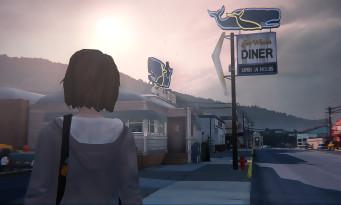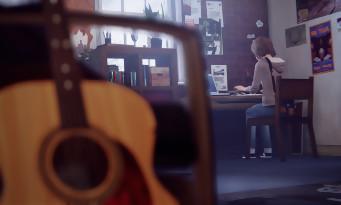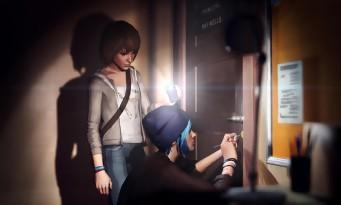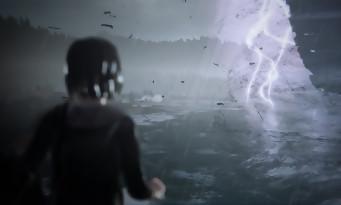 At the beginning of the year, in his review of the very first episode of Life is Strange, Maxime told you about the difficulty of judging a game on its first playthrough. This is all the more true for Life is Strange, which really changed gear between the beginning and the end of its adventure, so much so that we do not know where to start... Remember Me was playing the card of a certain exoticism with its futuristic Paris. Life is Strange changes course to take us to Arcadia Bay, a small port town in Oregon, where Maxine grew up, alongside her childhood friend Chloe. After an unfortunate move and five years spent in Seattle, Max returns to Arcadia Bay to join the famous Blackwell Academy and its photography department. But water has flowed under the bridges... The young artist has now lost contact with Chloé and her return to school, in the midst of outgoing and arrogant students, promises to be particularly thorny. Fortunately, the Universe is a great prankster. He decided to make it all a lot funnier, by fitting into Maxine's schedule an end of the world, unexplained disappearances and a power that allows her to go back in time.
At the beginning of the year, in his review of the very first episode of Life is Strange, Maxime told you about the difficulty of judging a game on its first playthrough. This is all the more true for Life is Strange, which really changed gear between the beginning and the end of its adventure, so much so that we do not know where to start... Remember Me was playing the card of a certain exoticism with its futuristic Paris. Life is Strange changes course to take us to Arcadia Bay, a small port town in Oregon, where Maxine grew up, alongside her childhood friend Chloe. After an unfortunate move and five years spent in Seattle, Max returns to Arcadia Bay to join the famous Blackwell Academy and its photography department. But water has flowed under the bridges... The young artist has now lost contact with Chloé and her return to school, in the midst of outgoing and arrogant students, promises to be particularly thorny. Fortunately, the Universe is a great prankster. He decided to make it all a lot funnier, by fitting into Maxine's schedule an end of the world, unexplained disappearances and a power that allows her to go back in time.
NILIN, MAXINE: SAME FIGHT
 This ability is one of the common traits between Remember Me and Life is Strange, in addition to its main female character. Nilin could alter a person's memories, replaying them over and over again, manipulating them like a videotape. Maxine has something equivalent: following a chain of events that we let you discover, she realizes that she can rewind the last moments of her life, again like a video tape recorder, to possibly change what she deems necessary. You guessed it, this is the heart of Life is Strange, which will both revolve its plot around this extraordinary ability, but also base its gameplay on it. We are here halfway between a Quantic Dream game, for handling or interactions with the environment, and a Telltale production, for the dialogue part, multiple choices and variable consequences. Because, beyond the riddles like puzzle-games based on Maxine's power, it will essentially be a question of choice. As announced before the game even started, Life is Strange wants the player to understand that his decisions can have an impact on the whole game.
This ability is one of the common traits between Remember Me and Life is Strange, in addition to its main female character. Nilin could alter a person's memories, replaying them over and over again, manipulating them like a videotape. Maxine has something equivalent: following a chain of events that we let you discover, she realizes that she can rewind the last moments of her life, again like a video tape recorder, to possibly change what she deems necessary. You guessed it, this is the heart of Life is Strange, which will both revolve its plot around this extraordinary ability, but also base its gameplay on it. We are here halfway between a Quantic Dream game, for handling or interactions with the environment, and a Telltale production, for the dialogue part, multiple choices and variable consequences. Because, beyond the riddles like puzzle-games based on Maxine's power, it will essentially be a question of choice. As announced before the game even started, Life is Strange wants the player to understand that his decisions can have an impact on the whole game.
LET'S BE NICE, LET'S REWIND
 Unlike the Telltale games, Maxine's power allows her to experiment. So you can try a solution, observe the short-term consequences, and back out if you don't like it. Dontnod puts a different kind of pressure on you: you make decisions whose outcomes you know. At least, that's what the game tries to make you believe. In reality, some choices will have a long-term impact that you may not necessarily suspect at the time. It's a strength of Life is Strange, these mechanics that remain hidden, out of control, leaving the player voluntarily in the dark. But at the same time, some may feel frustrated with the lack of feedback on the impact of certain choices. The rewind system pushes you to search, explore all the possibilities, try again, see the different reactions, multiply the solutions to the problems you are faced with. We then discover the richness of the background created by Dontnod, we indulge in contemplation, reading the notes and documents scattered from right to left... But ultimately, the rewind remains the only real mechanism that emerges from the experience, even if Dontnod tries a few small experiments at the end of the game (successfully by the way).
Unlike the Telltale games, Maxine's power allows her to experiment. So you can try a solution, observe the short-term consequences, and back out if you don't like it. Dontnod puts a different kind of pressure on you: you make decisions whose outcomes you know. At least, that's what the game tries to make you believe. In reality, some choices will have a long-term impact that you may not necessarily suspect at the time. It's a strength of Life is Strange, these mechanics that remain hidden, out of control, leaving the player voluntarily in the dark. But at the same time, some may feel frustrated with the lack of feedback on the impact of certain choices. The rewind system pushes you to search, explore all the possibilities, try again, see the different reactions, multiply the solutions to the problems you are faced with. We then discover the richness of the background created by Dontnod, we indulge in contemplation, reading the notes and documents scattered from right to left... But ultimately, the rewind remains the only real mechanism that emerges from the experience, even if Dontnod tries a few small experiments at the end of the game (successfully by the way). With a little perseverance, Life is Strange eventually unfolds. The plot thickens slowly, shifting from a teenager's diary to a sometimes poignant fiction, maturing to end up in a mystical-physical trip.
 Faced with this relatively limited interactive dimension, Life is Strange obviously imposes a strong narrative and a writing which, if not free from flaws, ends up gradually taking on episodes, which are not all the same quality. After the first episode, and to a lesser extent after the second, many players risk letting go of the controller: clichés galore, lengths that are difficult to bear, sloppy dialogues, nostalgia and melancholy that are far too present... Aesthetically successful despite a lazy lip sync , the game initially leaves this impression of being in a bad Sundance film, where teenage problems mingle with sunsets and folk music. Then, with a bit of perseverance, Life is Strange eventually unfolds. The plot thickens slowly, shifting from a teenager's diary to a sometimes poignant fiction, maturing to end up in a mystical-physical trip. The moments of grace eventually arrive, accompanied by an excellent quality soundtrack as long as you are not allergic to guitars and we finally let ourselves be invaded by this end of everything atmosphere that gradually envelops Arcadia Bay.
Faced with this relatively limited interactive dimension, Life is Strange obviously imposes a strong narrative and a writing which, if not free from flaws, ends up gradually taking on episodes, which are not all the same quality. After the first episode, and to a lesser extent after the second, many players risk letting go of the controller: clichés galore, lengths that are difficult to bear, sloppy dialogues, nostalgia and melancholy that are far too present... Aesthetically successful despite a lazy lip sync , the game initially leaves this impression of being in a bad Sundance film, where teenage problems mingle with sunsets and folk music. Then, with a bit of perseverance, Life is Strange eventually unfolds. The plot thickens slowly, shifting from a teenager's diary to a sometimes poignant fiction, maturing to end up in a mystical-physical trip. The moments of grace eventually arrive, accompanied by an excellent quality soundtrack as long as you are not allergic to guitars and we finally let ourselves be invaded by this end of everything atmosphere that gradually envelops Arcadia Bay.

























